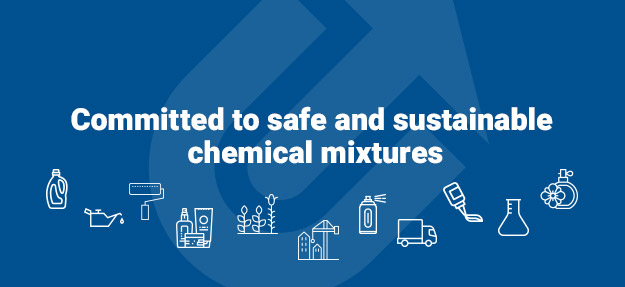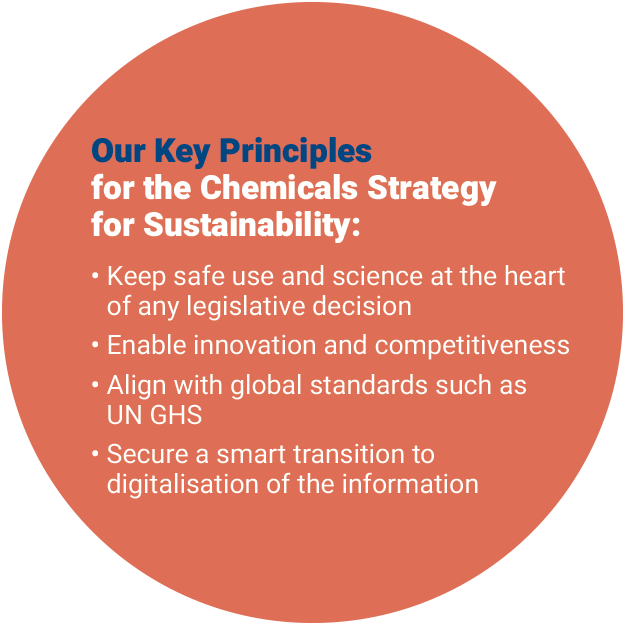Supporting the
implementation of REACH
REACH is the European Regulation on Registration, Evaluation, Authorisation and Restriction of Chemicals [Regulation (EU) 1907/2006]. It is the world’s most comprehensive regulatory framework securing safe use of chemicals. Recent European Commission reviews concluded that the system is fit for purpose, delivering on its objectives and serves as a global model for chemicals legislation. DUCC agrees with these conclusions and is committed to making REACH work.
DUCC recognises the importance of developing and using harmonised formats to facilitate communication along the supply chain. DUCC contributed to the drafting and implementation of ECHA’s CSR/ES Roadmap, and was a founding partner in the formation of ENES, the Exchange Network on Exposure Scenarios - a collaborative network set up in 2011, bringing together ECHA, Member State Competent Authorities and industry organisations to develop effective communication exchange between supply chain actors on the safe use of chemicals.
For communication upstream to substance registrants, the Use Map package was co-developed by DUCC under the above programmes, and all available use maps and related exposure assessment inputs (SWEDs, SCEDs and SPERCs) from downstream user sectors are available in the library hosted by ECHA, as well as the websites of the sector associations.
For communication downstream to end users, DUCC created and promotes the SUMI (Safe Use of Mixtures Information) approach and communication template.
Besides activities related to supply chain communication as above, DUCC engages on other REACH topics with impacts for downstream users, such as substance evaluation, DU Chemical Safety Assessment, authorisation/restriction and the interface with occupational safety and health. DUCC believes that full supply chains should be involved in identification of chemicals of concern and Risk Management Options Analysis, since industry has the resources and expertise to help in defining concepts and finding appropriate solutions.
In the context of the targeted revision of REACH, DUCC stands ready and committed to support EU decision-makers, with the goal to build on the existing solid REACH framework and make it more efficient, consistent and streamlined.
To access all DUCC materials related to REACH implementation visit the Resources page.
Supporting the
implementation of CLP
CLP is the European regulation on classification, labelling and packaging of substances and mixtures [Regulation (EU) 1272/2008]. It implements at EU level the United Nations Globally Harmonized System of Classification and Labelling of Chemicals (UN GHS), and has been proven to enhance the safe handling, storage, trade and disposal of chemicals.
The UN GHS creates an international level playing field for a growing number of countries, contributing to the implementation of SAICM (Strategic Approach to International Chemicals Management), which is a key objective of the European Commission’s global agenda reiterated in the Chemicals Strategy for Sustainability.
DUCC has engaged on the development and updating of the CLP regulation since its earliest days, including participation in Competent Authorities meetings and sub-groups on its Adaptation to Technical Progress and on new hazard classes. As the voice of industries providing safe and sustainable chemical mixtures, DUCC has been an active stakeholder throughout the development of harmonised information on hazardous mixtures for emergency response (CLP Annex VIII) and the tools for Poison Centres Notification, as well as provisions on labelling and packaging.
DUCC and its members have also contributed actively to the development of official guidance by ECHA, and collaborated with other industry stakeholders to produce user-friendly introductory information on specific requirements of CLP.
Recent reviews of EU legislation confirmed that CLP is an effective and powerful tool to enhance the safe use of chemicals. Despite these findings, the European Commission plans a revision of CLP, including the introduction of new hazard classes prior to discussion at UN GHS level. DUCC is of the opinion that new hazards must be based on internationally recognised definitions and agreed on global level to maintain the level playing field for European industry. They should also reflect alternative methods to minimise the need for animal testing, and avoid increasing label complexity and compromising clear communication of hazards.
DUCC members are highly committed to the successful implementation of CLP and emphasise the importance of stakeholder dialogue and impact assessment. DUCC stands ready to engage with the European Commission and other stakeholders to support the revision of the CLP Regulation.
To access all DUCC materials related to CLP implementation visit the Resources page.


